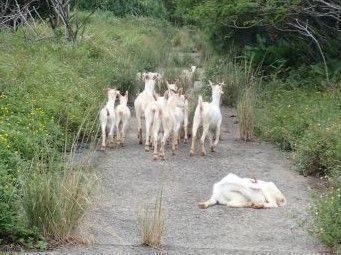
July 29, 2022 Ryukyu Shimpo
By Masatoshi Inafuku and Kenshiro Nishime
One year after being registered as a World Natural Heritage Site, Iriomote Island in Taketomi, Okinawa has a growing population of feral goats. The increasing number of goats is negatively impacting the ecosystem and environment of the island, and has people worried. By the end of 2022, the Okinawan government plans to include wild goats on a list of species that require a focused response within the list of invasive species in Okinawa. An experimental eradication of the goats will begin in October.
The International Union for Conservation of Nature (IUCN) has designated goats among “100 of the World's Worst Invasive Alien Species”. On Amami Oshima in Kagoshima Prefecture, damage caused by the goats eating has worsened soil erosion and caused landslides on the cape.
According to the Iriomote Wildlife Conservation Center, many goats have been sighted in the area around Mt. Komi in the eastern part of Iriomote Island. In 2017, feral goats began to appear on the cameras the center had set up to monitor the Iriomote cat population. Reports of sightings by locals also began to increase around the same time.
In 2020, the Ministry of the Environment killed three goats on Iriomote Island as part of emergency trapping activities. In 2021, the ministry killed another 61 goats between December and the end of March in order to investigate trapping techniques.
According to a member of the Iriomote Wildlife Conservation Center, “until last year, it seemed like there were maybe 100 goats on the island. But after 61 goats were eradicated last year, it has started to seem like there are far more than we thought.”
The center is also calling on the local government in Taketomi to consider establishing regulations around the appropriate raising of goats.
There are 375 species, including goats, on the Okinawa list of invasive species. Within that list, 15 species are listed as species that require a focused response. These include the mongoose, the Taiwanese habu, and the green anole and are the targets of focused control and eradication activities. As of now, goats are not included in this smaller list. However, the list will be revisited during 2022, and there are plans to add goats to this category.
Originally, the plan was to begin conducting habitat surveys and investigating trapping methods after the goats are named a species that requires a focused response. However, with growing calls for the goats to be eradicated, it has been decided to begin eradication efforts ahead of schedule.
(English translation by T&CT and Ellen Huntley)



